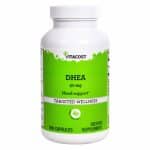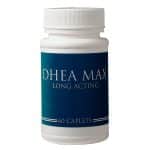The majority of clinical studies that research the effects of DHEA on weight or fat loss, as well as obesity, recommend its use for this purpose.
Metabolic syndrome
Metabolic Syndrome is characterized by several health conditions that are all associated with an elevated risk of cardiovascular disease, including increased insulin resistance, obesity, and abnormal cholesterol levels. In the metabolic syndrome, these individual risk factors act synergistically, making the overall risk of heart disease higher than for each of the factors taken separately. Although research continues, scientists have established the link between high cholesterol and low DHEA levels. Long-term DHEA supplementation increases insulin sensitivity by 30%, increases high-density lipoprotein cholesterol by 12%, and decreases low-density lipoprotein cholesterol by 11% and triglycerides by 20%. The decrease in low density lipoproteins (LDL) by DHEA has an antioxidant effect, which could have anti-atherogenic consequences. DHEA also decreases abdominal fat, an important feature of metabolic syndrome.
Clinical studies
The P. Diamond group from Quebec, Canada, carried out a 12-month study with 15 women aged 60 to 70, who applied a DHEA cream at 10% to their skin. An increase of 3.8% (P<0.05) in femoral fat and 3.5% (P<0.05) in femoral muscle was observed after 12 months. These changes in muscle and fat mass were associated with a decrease of 11% (P < 0.05) in fasting blood glucose and 17% (P < 0.05) in fasting insulin.
A double-blind randomized study, with a placebo group, was conducted by the Washington University School of Medicine from June 2001 to February 2004. Participants: 56 people with an average age of 71 (28 men and 28 women aged 65 to 78 years old) suffering from a disease linked to the decrease in DHEA levels induced by aging. Participants were randomly given 50 mg/day of DHEA or a placebo, for 6 months. The first measures involved changes in abdominal visceral and subcutaneous fat, measured by magnetic resonance imaging and the glucose/insulin response to an oral glucose tolerance test (TOTG). Of the 56 subjects, 52 were followed up post-study.
Compliance with the protocol was 97% by the group taking DHEA and 95% for the group taking a placebo. Based on the analyses, DHEA therapy compared to placebo, showed a significant decrease in visceral fat area (-13 cm2 versus +3 cm2, respectively; P=0.001) and subcutaneous fat (-13 cm2 versus + 2 cm2, P=0.003). The insulin level below normal during the oral glucose tolerance test (TOTG) was significantly reduced after 6 months of treatment for the DHEA group compared to the placebo group (-1119 µU/ml per 2 hours versus + 818 µU/ml per 2 hours, P=0.007).
Despite the low insulin level, the glucose level remained unchanged, resulting in a significant increase in insulin sensitivity for the DHEA group compared to the placebo group (+1.4 vs -0.7, P=0.005). DHEA supplement therapy may play a role in the prevention and treatment of metabolic syndrome associated with abdominal obesity.




